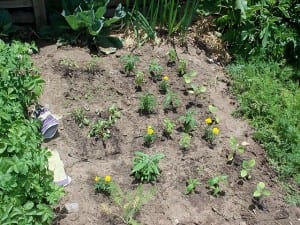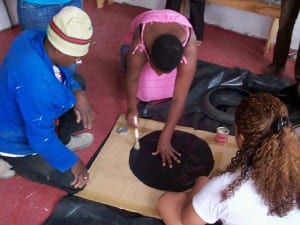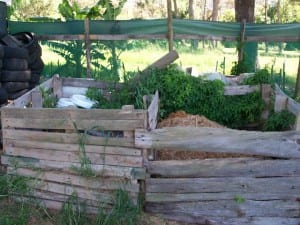Methodology
 The mission of the Gardens Team was to work with the residents of Monwabisi Park to research and implement a sustainable agricultural system that could help provide nutritional and aesthetic benefits to the community. The team analyzed the feasibility and benefits of instating community based gardening. In addition, the team researched methods of removing pathogens from the potentially harmful byproduct of the proposed dry composting toilet system.
The mission of the Gardens Team was to work with the residents of Monwabisi Park to research and implement a sustainable agricultural system that could help provide nutritional and aesthetic benefits to the community. The team analyzed the feasibility and benefits of instating community based gardening. In addition, the team researched methods of removing pathogens from the potentially harmful byproduct of the proposed dry composting toilet system.
Objectives
- Characterize the Key Aspects of the Local Environment
- Develop Community Based Educational Supplements
- Research and Implement Different Types of Example Gardens
- Research and Propose Methods of Removing Pathogens from Compost and Integrate Byproducts in Community Gardening Efforts
Characterizing the Monwabisi Environment
 In conjunction with members of the Monwabisi community, we explored the current agricultural conditions in the area. By physically seeing the surroundings, we obtained a clear understanding of how our project needed to be focused in order to affect the most significant change for the residents. The soil in the community is unfertile, dry, and lacking nutrients. We were able to create a listing of what types of vegetables community members could grow and what methods were used to ensure success. We supplemented our optical observations with interviews of current community gardeners, and others with no gardening experience. We also conducted interviews with our co-researchers (community members hired by the Cape Town Project Centre to aid us in our research), through which we deducted that creating a sustainable gardening program that encompassed the entire park would be non-realistic since many community members would not find it practical to use gardening as a source of food.
In conjunction with members of the Monwabisi community, we explored the current agricultural conditions in the area. By physically seeing the surroundings, we obtained a clear understanding of how our project needed to be focused in order to affect the most significant change for the residents. The soil in the community is unfertile, dry, and lacking nutrients. We were able to create a listing of what types of vegetables community members could grow and what methods were used to ensure success. We supplemented our optical observations with interviews of current community gardeners, and others with no gardening experience. We also conducted interviews with our co-researchers (community members hired by the Cape Town Project Centre to aid us in our research), through which we deducted that creating a sustainable gardening program that encompassed the entire park would be non-realistic since many community members would not find it practical to use gardening as a source of food.
Agro-Educational Supplementation
Our team recognized that the best way to achieve sustainability in the community was to certify that there would be educational supplements in place, which community members could utilize at their leisure. To achieve this goal we first invited one of our sponsors, Pat Featherstone from the organization Soil for Life, to give a tutorial on water-wise gardening practices, and how to grow the most nutritional foods in the smallest amount of space. Any interested community members were encouraged to attend this seminar. Attendance was minimal but those who were present were very interested and gained a large amount of useful knowledge. Our second procedure in ensuring sustainable educational practices was designing pamphlets detailing the processes taught at Soil for Life’s seminar. In conjunction with the co-researchers, we were able to translate our pamphlets into Xhosa, the language spoken most frequently in Monwabisi Park, in order to make the information more widely accessible. Copies of these pamphlets will be available to any interested persons at the new community centre. Our final stage of the education piece of our project was to set up model gardens enlisting various permaculture techniques around the community centre and crèche of the Indlovu Project. By working with community members in installing these gardens, we were able to ascertain the most efficient practices collectively. The involved community members have thus gained experience and knowledge that can be communicated with the rest of the population.
Implemented Gardening Practices
 Around the Indlovu Centre, we planted container gardens as examples for the community. We used easily accessible materials, the most common being tires from the dump at the back of Monwabisi Park. We combined the ground soil with donated compost to create a more fertile environment inside the containers. We planted herb and vegetable seedlings in a way such that each seedling was paired with its most suitable companion for optimal growth. In addition to the many vegetable and herb container gardens, we also planted a medicinal garden for use by the crèche at the Indlovu Centre.
Around the Indlovu Centre, we planted container gardens as examples for the community. We used easily accessible materials, the most common being tires from the dump at the back of Monwabisi Park. We combined the ground soil with donated compost to create a more fertile environment inside the containers. We planted herb and vegetable seedlings in a way such that each seedling was paired with its most suitable companion for optimal growth. In addition to the many vegetable and herb container gardens, we also planted a medicinal garden for use by the crèche at the Indlovu Centre.
We also planted aqua-trap gardens around the Indlovu Centre. Aqua-traps are meant to catch water and compost while allowing the soil to be more water efficient and nutrient enriched. To create an aqua-trap we cut off the front side of a tire and super glued a section of black tarp over the hole in the middle. After creating the aqua-traps themselves, we worked with Xolani, the community gardener, to dig a hole large enough to place two traps in the bottom. We filled the hole with a mixture of compost and ground soil. In the bed we created, we planted a variety of seedlings and built a short wall around the garden to protect the seedlings from the wind and from pests. The aqua-trap method is an inexpensive, uncomplicated, and effective way to create gardens in areas where resources to care for gardens, such as water and compost, are not always available.
While creating our demonstration gardens, all of the compost had to be donated from an outside source. In order to eliminate the need for a constant donation of compost, we designed and implemented a worm garden for the community centre. Vermiculture is an excellent way to compost common organic waste and it requires little maintenance. To create the worm garden, we bought a bathtub from a vender in Monwabisi Park and designed a platform for it to rest on behind the community crèche building. The downfall to this system is the fact that the start-up cost is relatively high, making earthworm gardens a viable option for implementation only in a community garden situation, such as the Indlovu Project.
Composting as Part of the Proposed Sanitation Facility

Composting Bins at the Soil for Life Garden
Proposed for the park is a new sanitation facility containing water taps, a laundry station, and a dry composting toilet system. The composting toilets will produce a solid byproduct, which will contain many potentially harmful pathogens. For this reason, the compost cannot be directly applied in gardening for food. We created a proposal suggesting methods for dealing with ‘unsafe’ human compost. The hope is that by treating the waste produced by the toilets, the compost can be used to enrich the soil of the park and allow residents to grow their own food more easily. Dependant on the implementation of a new toilet system in Monwabisi Park, this proposal could be a starting point for a University of Cape Town student to being a research and development project.
The composting proposal includes two options for pasteurizing compost and a supplementary option for removing pathogens using effective microorganisms. It contains a brief summary of each option as well as a short plan for implementation. The team also included suggestions as to which system would provide the most benefits and be the most sustainable in Monwabisi Park.
[09Gardens]


